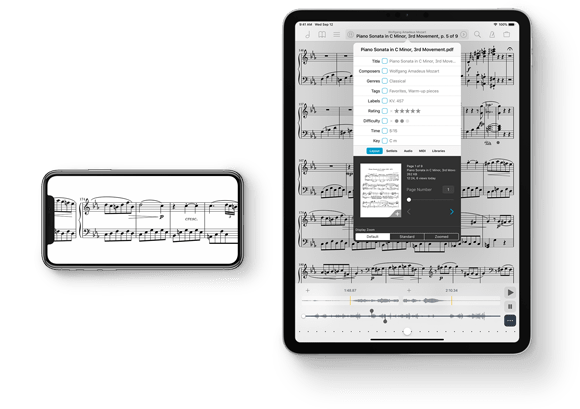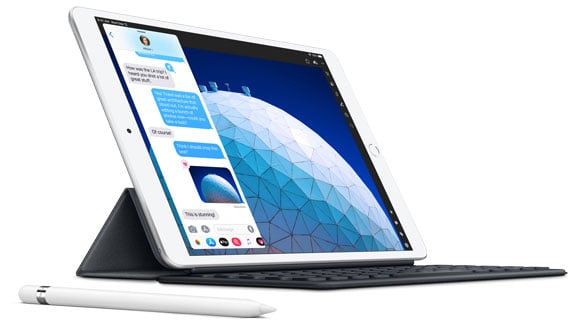
We just announced forScore 11 and with this update we’re doing something a little different: we’re taking advantage of the newer public beta feature of Apple’s TestFlight service. This feature makes testing far simpler—instead of sending us your information, you simply install the TestFlight app and tap the link on our beta page from your iPad or iPhone. Space is limited, so if you’re interested don’t delay!
The currently available build is actually our sixth beta version, so it’s near-final and more stable than a typical beta release. There’s always some risk that a feature might not work as expected, but if you’re interested in the many new features and upgrades coming soon to the App Store and want an early look, this is the best way yet to do so. Plus, you’ll be helping us make sure we tied up all of the loose ends and be a part of our final push to release day.
We’re incredibly excited about forScore 11 and we hope you are too! Whether you want to dive right in or wait until it’s released publicly, we appreciate your interest and support.

Today we’re very excited to be taking the wraps off of our latest major update to give you a sneak peek at our biggest new version in years. We’re closing the book on forScore 10 and forScore mini 3 to bring you the all-new sheet music reader for iOS, forScore 11.
This major new version of forScore is a single, universal app for iPad, iPhone, and iPod Touch. Buy it once to install it on all of your devices. In fact, two weeks ago we quietly discontinued forScore mini and updated forScore’s price accordingly in order to prepare for this restructuring. We’re sad to see forScore mini go, but we had to make room for a lot of great new stuff.
There’s way too much to breeze through here, so be sure to check out our new forScore 11 page to learn all about this incredible, free update. It’s jam packed and we can’t wait to get it to you in just a few short weeks!
forScore 11 Sneak Peek
Today Apple released iOS 12.2, so we wanted to mention that we’ve been testing with this latest update and forScore users should feel free to install it whenever they’re ready. In fact, there are two notable improvements made to this version that we wanted to call out.
First, this update fixes a system-wide issue when exporting PDFs that could cause semi-transparent annotations (like those made with default highlighter preset) to appear darker than normal, and could show artifacts especially around white markings.
This update also unexpectedly adds support for the Logitech Crayon to the latest generation of iPad Pros, the 11-inch and 12.9-inch (3rd generation). In our testing, we found them to be a great rugged alternative with few downsides. If you’ve got an iPad Pro and couldn’t justify the price of the Apple Pencil 2, this cheaper alternative definitely deserves a look.

Logitech’s Crayon doesn’t support pressure sensitivity, but it does support tilt and otherwise works similarly to the first generation Apple Pencil. The cap is built in so you can’t lose it, it charges with a cable so there’s no need to awkwardly plug it in to the bottom of your iPad, and it doesn’t require pairing so it’s even easier to set up. It’s a utilitarian tool that in many ways makes up for some of the more curious choices Apple made with their first Pencil, and overall it’s a great option that we’re happy to recommend.

Today Apple introduced two new iPads and while their lineup has never been more complicated, there have also never been so many great options for customers to find one that best suits their needs. While we haven’t yet been able to test them, we expect that forScore will be fully compatible with the two newest models right out of the box. Their form factors and screen sizes aren’t new, and every major hardware feature (like Apple Pencil support) has been previously available in other devices, so there shouldn’t be any surprises.
There was a time when Apple’s product refreshes offered a new vision for their lineup: these older things are gone now, and they’re being replaced by better ones. Now, products slip downward from tier to tier as they age, with Apple continuing to offer them for lower prices or in select markets. It’s not as exciting, but in the end it’s a great thing for users. Whether you’re looking to get started with your first device or thinking of upgrading an older one, now’s a great time to check out Apple’s latest offerings.
If you’ve been interested in trying out forScore or seeing what the latest and greatest iPads have to offer, there’s never been a better time to head down to your local Apple retail store or third-party reseller. At many locations worldwide, including stores like Best Buy, forScore is currently featured on demo iPad Pros so you can see it in action and test it out for yourself. Where available, it’s also a great opportunity to try annotating with the new Apple Pencil 2 and using its double tap gesture.
We’re incredibly honored and thrilled to have been chosen to appear alongside many other amazing apps in this setting, and we think a lot of curious musicians will really benefit from the chance to experience it firsthand.




